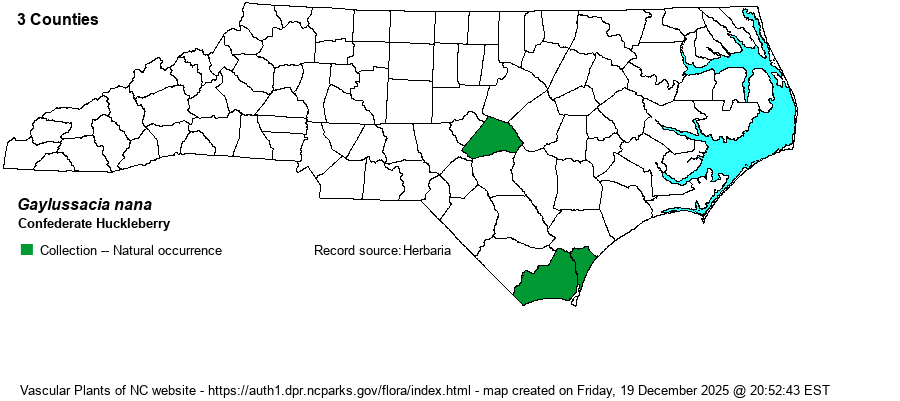| Author | (A. Gray) Small | |
| Distribution | Limited, as far as known, to just a few sites in the southeastern corner of the state (Brunswick and New Hanover counties). There also is a specimen at NCU from Harnett County, collected in 1996 on Fort Bragg; it was verified in 2021. Assuming that there is no error in the location data, we accept this record.
This is a Southern species, ranging from southeastern NC to central FL, and west only to eastern LA. It is disjunct from Berkeley County, SC, to Brunswick and New Hanover counties, with no records as yet from Georgetown and Horry counties in SC and Brunswick County in NC.
| |
| Abundance | Very rare in NC. This is a State Endangered species. | |
| Habitat | This species occurs in xeric to mesic sandy forests. The NC NHP lists it as occurring mostly in Coastal Fringe Sandhill natural community. The Fort Bragg plants occurred in wet soil (unusual for this species) at the base of a savanna-like slope adjacent to a streamhead seepage bog. | |
| Phenology | Blooms in March and April. Fruits in June or July.
| |
| Identification | This is a very short, clonal deciduous shrub, ranging only 1-1.5 feet tall, rarely to 3 feet tall. The leaves are quite similar to those of G. frondosa, being glaucescent overall and whitish beneath, resin-dotted below, and with a rounded tip. Most references and keys state that G. nana has young twigs densely hairy, whereas G. frondosa has glabrous young twigs; however, research by BA Sorrie showed that twigs of G. nana vary from hairy to glabrous. Identification is best made by the color of the glandular dots on leaf undersides: red in nana and yellow (and smaller) in frondosa. Many nana individuals show strongly ascending to nearly upright leaves, and even a few upright flower cluster stalks; whether this is a consistent field mark separating it from the very common frondosa is not clear. | |
| Taxonomic Comments | This species has often, and until recently, been considered as a part of G. frondosa; that is, a variety named as G. frondosa var. nana. Weakley (2018), NatureServe, and many other recent references consider it a valid species.
| |
| Other Common Name(s) | Dwarf Dangleberry is often used as a common name. However, if that name is used, then the user should name G. frondosa as Large Dangleberry or Great Dangleberry, etc. (as opposed to simply “Dangleberry”). | |
| State Rank | S1 | |
| Global Rank | G4 | |
| State Status | E | |
| US Status | | |
| USACE-agcp | UPL link |
| USACE-emp | FACU link |

